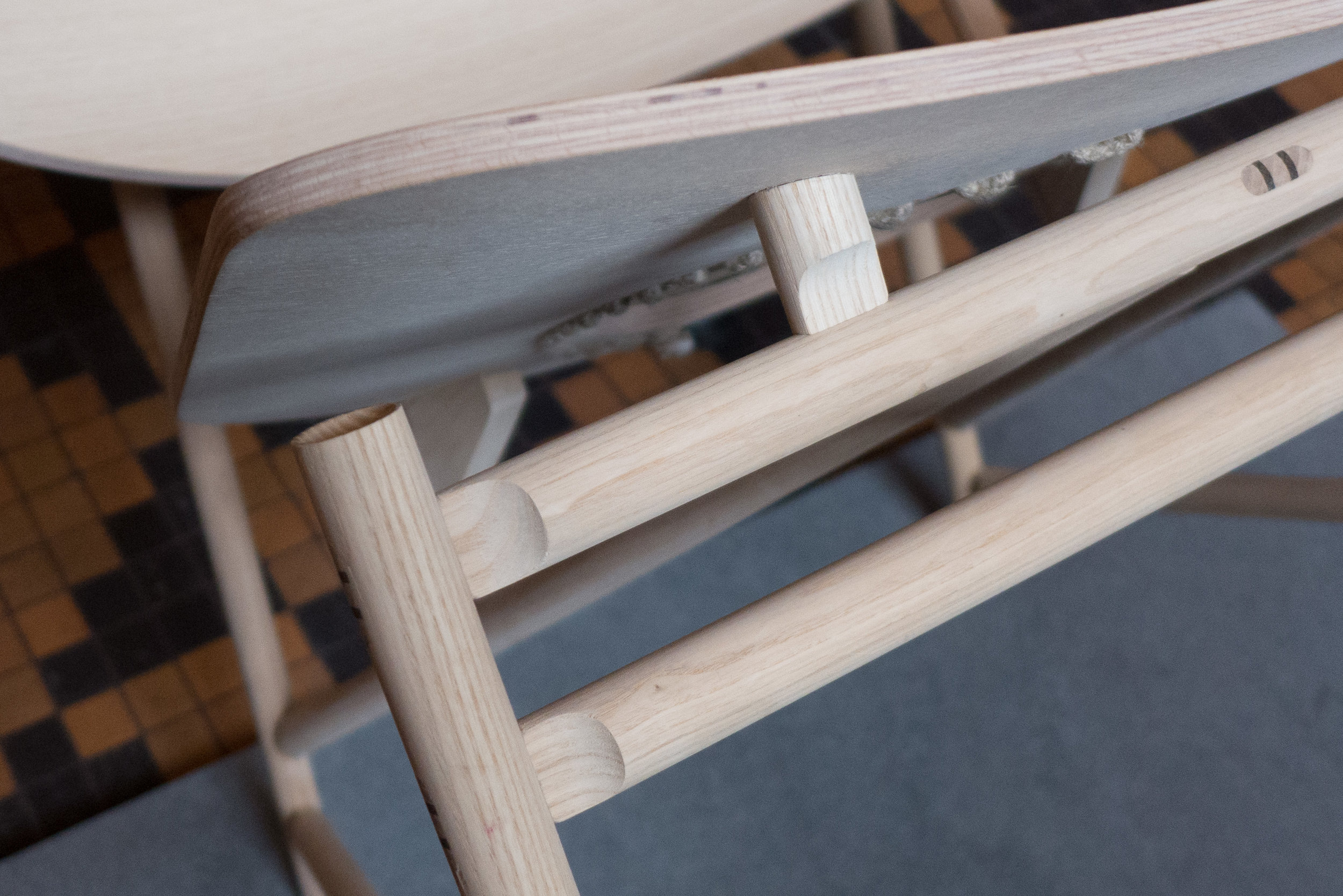Sunrise by Lise and Hans Isbrand - MONO catalogue 26
/The large oval-shaped seat and the backrest of the chair are in laminated wood or plywood that are curved in just one plane and rest lightly on a thin and elegant framework or scaffold in ash.
Ash has a straight and regular grain and this is exploited in the construction with the parts of the frame turned and reduced to a small cross section so the pieces are barely more than the thickness of a dowel.
For a framed chair in wood the simple and common form has a square or circular frame that supports the seat with, normally, two legs at the front, often but not always housed into the underside of the frame, and with two legs at the back that continue above the level of the frame to support a piece of timber for a back rest that is set either vertical or at a slight angle for more comfort and is either between the upper parts of the back legs or fixed across the front of the two uprights. To keep the legs in place the next stage is to add stretchers - lengths of timber between the legs to stop them splaying out and if stretchers are added then the timber of the legs can be thinner.
It doesn't really have to be spelt out like that here except that it shows just how many of those conventions the Isbrands play with and subvert to create such an elegant framework of wood to support the seat and the backrest of their chair.
The other basic elements of construction that should be pointed out is that horizontal and vertical parts of a chair are usually fixed together with mortice and tenon joints with the mortice or slot in the main and usually thicker timber and the tenon or tongue that is fixed into the mortice is usually on the end of the thinner secondary timber. The classic ways to stop the tenon pulling out is either to drill a hole through the side of the mortice and tenon and drive through a peg to hold the two pieces together or to cut a slot across the end of the tenon and, when the timber is in place - with the tenon in the mortice - then a wedge is driven into the end to expand the tenon and stop it pulling out. The strength of the joint is greater the more precisely it is cut and often it is the shoulder, at the point where the timber is reduced in size at the start of the tenon, that has to be well cut, to keep the pieces at the right angle,
In Sunrise the tenons are rounded off at the top and bottom to form an extended oval shape and there are two wedges in dark wood to keep the tenon from pulling out so this becomes a strong decorative feature of the chair frame. The tenons do not have a pronounced shoulder but there are hollow curves back from the joint itself to make the transition from the tenon to the full thickness of the timber.
The frame is complicated. Perhaps the most conventional part is the front frame with two vertical legs with two stretchers - one just below the top of the legs and a second stretcher just below that.
The two back legs are set out at a pronounced angle and do not support the back rest directly but are housed into short verticals that support the back rest and are rather like props. The two vertical supports for the backrest do not run down to the ground but are housed into long raking struts that run from the top stretcher between the front legs angled down and out to the back legs.
The laminated seat rests at the front on short collars or spacing pieces housed into the top of the upper stretcher and the back of the seat is supported on short brackets out from the lower part of the struts that support the back rest.
Again, as with the front of the seat, there are short spacers between the struts and the curved back rest.
To stop the back legs moving outwards there are low stretchers, just above the ground, between the front and the back legs.
There are very nice details to the frame like the deep cups shaped out of the tops of the legs.
Rather than having upholstery or a cushion for the seat there is a simple round hole cut through the laminated wood that is closed with halyard taken from side to side, woven by threading the rope down through small holes drilled around the opening.
Sunrise
MONO catalogue number 26
designed by: Lise and Hans Isbrand
produced by: MoreWood Møbelsnedkeri ApS
asketræ / ash
height: 75
width: 80
depth: 80 cm







































